#Borrell II
Explore tagged Tumblr posts
Text

Mapa dels comtats catalans a finals del segle X. Borrell II posseïa els comtats de Barcelona, Girona i Osona (947-993), i també el d'Urgell (948-993). Oliba I era comte de Berga i de Ripoll (998-1002). Oliba Cabreta era el comte de Cerdanya (965-988), amb els pagus de Berga i de Conflent, i comte de Besalú (984-988), amb el pagus de Vallespir. Després d'ell, Guifre II de Cerdanya i Berga fou comte de Cerdanya i Conflent (988-1035) i de Berga (1003-1035). Després d'Oliba Cabreta, a Besalú fou comte son fill, Bernat Tallaferro (988-1020). Al Rosselló foren comtes Gausfred I (931-991) i Guislabert I (991-1014). El Vallespir era vescomtat, part del comtat de Rosselló. N'era vescomte Guillem I (991-1028). A l'Urgell, després de Borrell II de Barcelona, hi governà son fill Ermengol I (993-1010). Al Pallars hi governaren en condomini els germans Ramon III i Borrell I (948-995). A la mort d'aquest darrer foren succeïts per son fill Ermengol I de Pallars (995-1010), que hi governà en condomini amb Sunyer I de Pallars (948-1011), fill de Llop I de Pallars (920-947). A la Ribagorça hi governaven Unifred (970-979), succeït per son germà Arnau (979-990), succeït per son germà Isern (990-1003).
#mapa#cartografia#història#història de Catalunya#història medieval#Història d'Europa#Catalunya#Comtats catalans#Catalunya comtal#segle X#Borrell II#comte de Barcelona#Comtat de Barcelona#Comtat de Girona#Comtat d'Osona#Comtat d'Empúries#Comtat de Besalú#Vescomtat de Vallespir#Comtat del Rosselló#Comtat del Conflent#Comtat de Cerdanya#Comtat d'Urgell#Comtat de Pallars#Comtat de Ribagorça
3 notes
·
View notes
Video
CARDONA-PINTURA-ART-ESTATUA-BORRELL II-PLAÇA DE LA FIRA-SUBIRACHS-MONUMENTS-PAISATGES-HISTORIA-FRANKFURT-LA FIRA-PINTOR-ERNEST DESCALS por Ernest Descals Por Flickr: CARDONA-PINTURA-ART-ESTATUA-BORRELL II-PLAÇA DE LA FIRA-SUBIRACHS-MONUMENTS-PAISATGES-HISTORIA-FRANKFURT-LA FIRA-PINTOR-ERNEST DESCALS- Un monumento a la historia de CARDONA y de CATALUNYA, la estatua ecuestre del Compte BORRELL II, obra del escultor SUBIRACHS, preside la escena paisajista en la punta de la Plaça de la Fira en el pueblo de CARDONA, las sombrillas del cercano Bar Frankfurt La Fira permanecen sin desplegar por la ausencia de sol en los días nubosos del final del invierno, entre los edificios y casas podemos ver la Església de Sant Miquel que ofrece magnificiencia al paisaje urbano. Pintura del artista pintor Enest Descals sobre papel de 40 x 70 centímetros, pintar los paisajes de los pueblos de la Comarca de El Bages en la provincia de Barcelona.
#SUBIRACHS#ESCULTOR#ESCULTURA#ESTATUA#BORRELL II#COMPTE#CARDONA#MONUMENTS#ECUESTRE#PLAÇA DE LA FIRA#MONUMENT#MONUMENTO#MONUMENTOS#BAR#FRANKFURT#LA FIRA#POBLE#POBLES#BAGES#COMARCA#BARCELONA#CATALONIA#CATALUNYA#CATALUÑA#URBAN#LANDSCAPE#CITYSCAPE#PAISATGE#PAISATGES#PAISAJE
0 notes
Text
youtube
LA ABADESA (2024)
Synopsis
In the 9th century, Emma of Barcelona (c. 880-942), a 17-year-old girl, is named abbess in order to repopulate and Christianize border territories in 897. Upon arriving at the abbey, she will have to overcome the mistrust aroused by a woman determined to fulfill her mission, which will lead her to confront nobles, like her brother Count Guifré II Borrel of Barcelona (874-911), peasants and the nuns themselves. Despite everything, Emma will show that it is possible to challenge established power structures. Although she will pay a high price to get it...
Emma is willing to carry out the commission of her deceased noble father, Count Guifré I of Barcelona, Guifré el Pilós (840-897), founder of the House of Barcelona: convert the abbey that he founded in 885, the Monastery of Sant Joan de les Abadesses, for which she is now responsible into the engine of change and transformation of a society that comes down. She must help with all her resources to help the lands that are emptied due to hunger caused by border wars, which in turn are a consequence of the ambitions of the feudal lords of the area.
Emma acquired small or large properties with which the monastery came to have a territory equivalent to that of a county. Her sovereignty was also similar to that of a countess: by concession from her father, her domains were exempt from all interference from the neighboring counts, whom she knew how to oppose with resistance.
On cinemas: Friday 22 March
Filming began in January 2023 at the Loarre Castle, and included scenes filmed at the Turó de la Seu Vella, until concluding at the end of February 2023.
Main cast
Emma of Barcelona - Daniela Brown
Eloisa - Blanca Romero
Guifré II Borrel of Barcelona - Carlos Cuevas
Eduard - Ernest Villegas
Odón - Oriol Genís
Bishop Gotmar of Vic– Joaquín Notario
Clara-Berta Sánchez Bajona
Melisenda - Anäel Snoek
Elvira- Olivia Auclair
Data sheet
Script and direction: Antonio Chavarrías
Produced by: Antonio Chavarrías, Jose María Morales, Miguel Morales, Mónica Lozano
Photography direction: Julian Elizalde
Editing: Clara Martínez Malagelada
Music: Ivan Georgiev
Casting: Irene Roqué, Carla Bisart, Sara Bisart, Elena Gómez Zarzuca and Doriane Flamand
Direct sound: Elsa Ruhlmann
Sound editing: Corinne Dubein
Blends: Emmanuel de Boissieu
Art direction: Irene Montcada
Costumes: Catherine Marchand and Pau Aulí
VFX: Natacha Brohan
Assistant director: Falele Ygueravide
Production direction: Anna Boneta
Executive producers: Alba Bosch-Durán, Flavia Biurrun and Jennifer Ritter
Co-producer: Huber Toint, Alex Verbaere, David Claikens, Samuel Feller
Production of Oberon Media, Wanda Films, Icono 2020, Saga Film, RTVE and TV3.

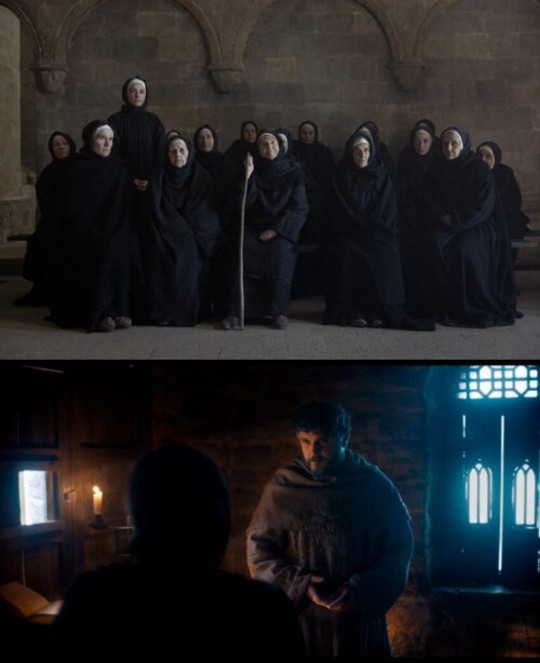
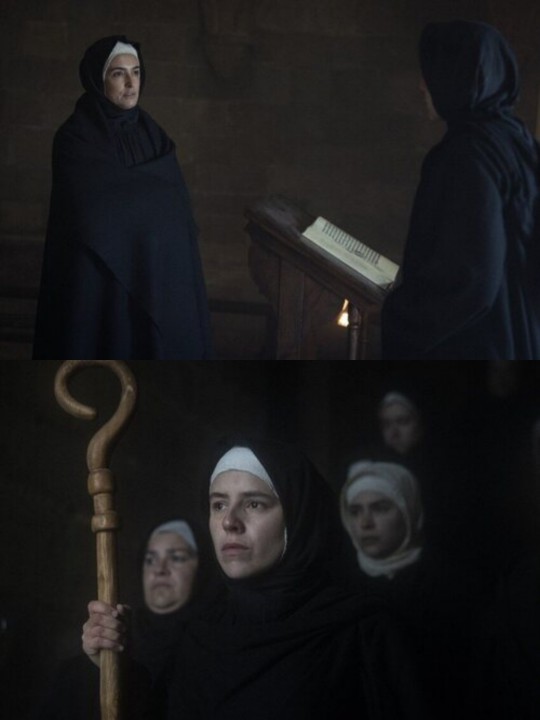
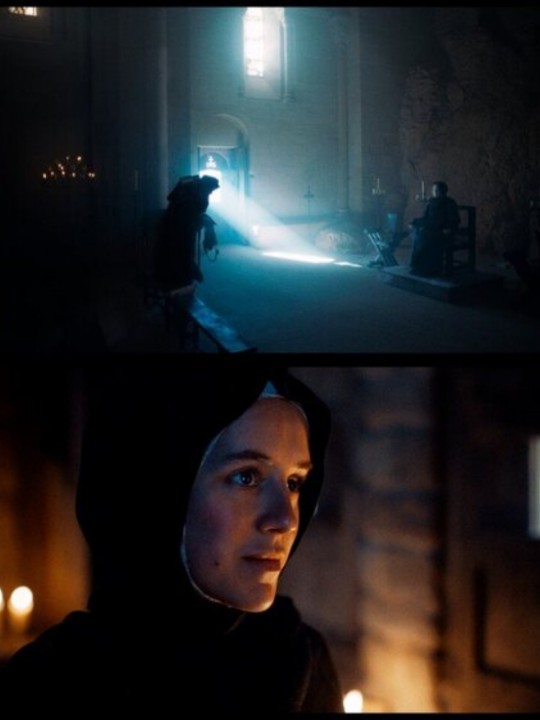
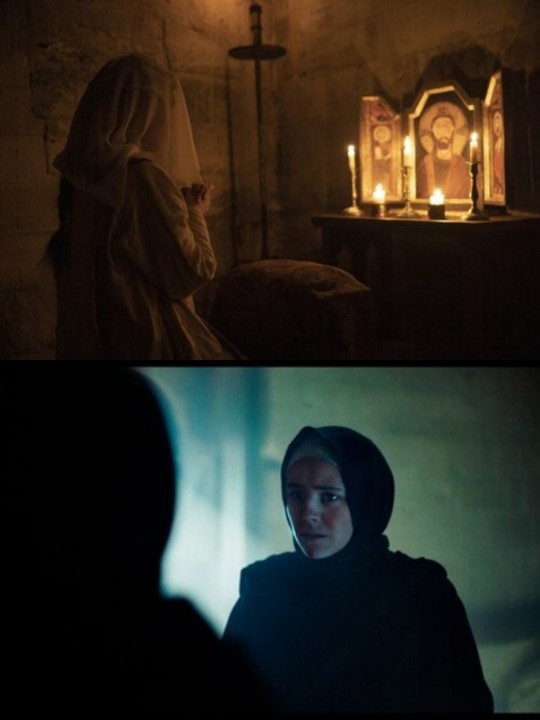

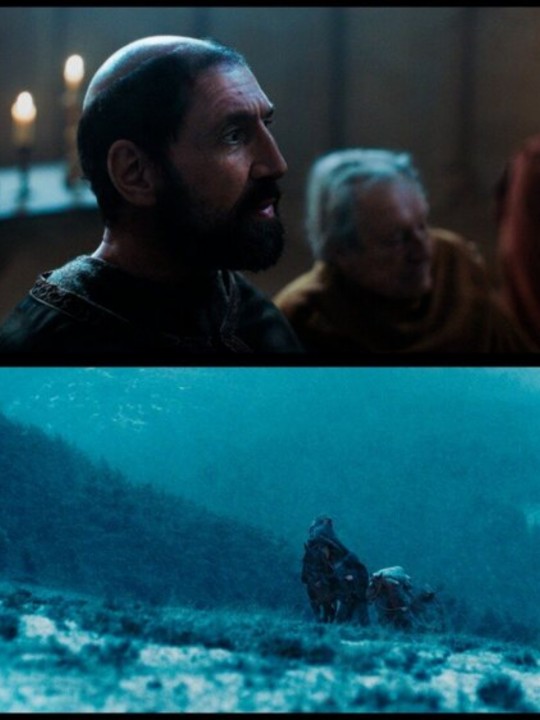


Poster

(Based on a true story/ Based on a true woman)
#the abbess#la abadesa#la abadesa 2024#period dramas#films#emma of barcelona#guifré ii borrel of barcelona#bishop gotmar of vic#antonio chavarrías#daniela brown#blanca romero#carlos cuevas#ernest villegas#oriol genís#joaquín notario#anäel snoek#9th century#berta sánchez bajona#olivia auclair#emma de barcelona#guifré ii borrel de barcelona#guifré ii de barcelona#guifré ii of barcelona#guifré i of barcelona#guifré i de barcelona#guifré el pilós#Sant Joan de les Abadesses#siglo ix
11 notes
·
View notes
Text
Silvestro II
Sterrekunde, meetkunde, rekenkunde: dit is die nuwe studiepale in Gerberto se opleiding wat in Katalonië aangekom het en by Vich toevertrou het aan biskop Attone, herorganiseerder van die studies van die kanonne, kenner van "wiskunde" (Richero) en eerste opleier van die kultuur van die Quadrivium (sterrekunde, rekenkunde, meetkunde, musiek) in Gerbert, wat in Katalonië werke van Boethius, Isidore van Sevilla, gesangboeke en antifone gekopieer by die plaaslike musiekskool volgens Katalaanse neumatiese notasie gelees het. Miskien het Gerbert in Ripoll vir Miro Bonfill, neef van graaf Borrell ontmoet: Miro, biskop van Gerona in 971, was 'n uitstekende letterkundige, kenner van Grieks, skrywer van woordelyste en formulariums. In die nabygeleë Barcelona het Gerberto ook in aanraking gekom met Sunifred Lobet, geestelike van die katedraal en vertaler van De astrologia, 'n verhandeling oor die astrolabium; van hom, baie na aan graaf Borrell, het Gerbert in 984 'n kopie van sy vertaling gevra. Gerona, Barcelona, Ripoll, Vich, miskien Cordova: dit is Gerberto se intellektuele omtrek in Katalonië. Ademar van Chabannes, in die 11de eeu, gee sy teenwoordigheid in Cordoba so seker: die mitografiese tradisie het goeie redes om krediet aan die nuus te gee, maar wat saak maak, is die rykdom, heterogeniteit en heterodoksie van hierdie adolessent se opvoeding wie se kultuur, nou gevorm, lyk toegerus vir nuwe historiese landskappe
Dr De Beer
#Silvestro II#afrikaans#south africa#Katalonië#Borrell#Richero#Boethius#Isidore van Sevilla#meetkunde#Sterrekunde#rekenkunde
0 notes
Text

Crazy how people ignore literally everything about the Dance to support bullshit that they just made up in their heads to justify backing the misogynist bootlicker side of the war.
Rhaenyra was supported by the vast majority of the houses, and that's just plain fact. How about we list them all:
House Velaryon, House Celtigar, House Staunton, House Massey, House Bar Emmon, House Darklyn, House Stark, House Tully, House Frey, House Hayford, House Harte, House Byrch, House Dustin, House Manderly, House Darry, House Blackwood, House Beesbury, House Caswell, House Costayne, House Borrell, House Buckerler, House Fell, House Arryn, House Corbray, House Cerwyn, House Hornwood, House Charlton, House Mallister, House Piper, House Roote, House Footly, House Vance of Wayfarer's Rest, House Smallwood, House Wode, House Burley, House Grimm, House Merryweather, House Mullendore, House Oakheart, House Rowan, House Royce, House Sunderland, and House Tarly.
House Yronwood- (the most powerful house in Dorne, aside from the Martells) -also supported Rhaenyra, even though the Martells remained neutral.
THAT'S 44 HOUSES!!!
Even House Bracken defected to the Blacks, even after first supporting the Greens---as did the City Watch of King's Landing.
And do you know how rare and insane it is for the Brackens and the Blackwoods to be on the same side? Like, if that tells you anything about who had the most support during the Dance, it definitely wasn't Aegon.
So, with a total of 45 houses that supported Rhaenyra and her claim, let's see how many supported Aegon:
House Hightower, House Cole, House Lannister, House Wylde, House Strong, House Peake, House Fossoway, House Roxton, House Norcross, House Ambrose, House Butterwell, House Rosby, House Stokeworth, House Mooton, House Lefford, House Swyft, House Reyne, House Tarbeck, House Crakehall, House Redwyne, House Baratheon, House Swann, House Vance of Atranta, House Graceford, House Risley, and House Leygood.
26 houses supported Aegon...and, not for nothing, but 4 of those houses originally supported Rhaenyra and only defected to the Greens because they were captured and told that they had to either swear fealty to Aegon II or die---meanwhile the Brackens defected to the Blacks of their own volition.
Even so, however, with Aegon's 26 houses, that still leaves Rhaenyra with 19 HOUSES MORE THAN AEGON! 45 houses v. 26! And that's at the END of the Dance after Aegon forced 4 houses to join his side, in the BEGINNING---putting those 4 houses on Rhaenyra's side and House Bracken on Aegon's side---Rhaenyra had 25 MORE HOUSES ON HER SIDE! 48 houses v. 23!
To really nail the point home:
In the beginning, Rhaenyra had 25 MORE houses on her side than Aegon did, which is more houses than Aegon had IN TOTAL!
Either way you slice it, beginning or end, Rhaenyra had the support of the vast majority of the houses.
As for the smallfolk not liking her, that's something that the show completely made up.
Firstly, it's clear that that play was less a vote of whether they liked Rhaenyra or not and more of a showcase of that societal misogyny TG is such a big fan of. They weren't making fun of Rhaenyra because they didn't like her, they were making fun of her because she's a WOMAN! If she were a man, the play wouldn't exist because they'd have no reason to make fun of her because her (him, in this case) being named heir would fall into their society's expectations.
Secondly, in the book the smallfolk do actually support her claim---she wasn't called "The Realm's Delight" for nothing. At Aegon II's coronation, no one cheered and people were asking for Rhaenyra; when Rhaenyra took over King's Landing, people cheered and celebrated; the only reason the smallfolk revolted against her was because the Greens raided the treasury and so Rhaenyra had to raise taxes to try and replenish what they stole; and are y'all seriously forgetting this passage in the book:
"When Prince Daemon sent forth his call to arms, they rose up all along the rivers, knights and men-at-arms and humble peasants who yet remembered the Realm's Delight, so beloved of her father, and the way she smiled and charmed them as she made her progress through the riverlands in her youth. Hundreds and then thousands buckled on their sword-belts and donned their mail, or grabbed a pitchfork or a hoe and a crude wooden shield, and began to make their way to Harrenhal to fight for Viserys's little girl.”
Rhaenyra was beloved by the smallfolk---despite what TG would have you believe---and they DID support her, alongside the majority of the houses. She had the stronger claim, the majority of the houses, the love of the smallfolk, the better cause, and her son sat on the throne at the end of it all---because the houses that supported her were truly LOYAL to her, something that can't be said for Aegon's supporters considering that he was literally poisoned by his own men.
Team Green trying to pretend that she wasn't loved and supported is just a deathly case of copium because they can't handle the fact that no one liked their rapist loser king 🤷♀️
145 notes
·
View notes
Text
Queen Daenaera Velaryon's Mermaid Crown

Daenaera is the daughter of the Lord Daeron Velaryon, who fought for both Queen Rhaenyra I and King Aegon III Targaryen.
It is obvious her family is Team Black no matter what antis want to say, and the marriage of Aegon and Daenaera was the best choice for him both as a political alliance and as a match.
Daenaera brought House Velaryon back to the royal family; her father Daeron Velaryon fought for Rhaenyra and for Aegon III Targaryen and his wife Hazel Harte and him seemed to have had a good relationship with Baela and Rhaena in order to entrust their daughter to them in case something happened to them (and sadly it did, my poor baby girl became an orphan at six years old 🥺).
After all the strife that happened to both House Targaryen and House Velaryon, Daenaera and Aegon met and wed each other.
Queen Rhaenyra I Targaryen had made a deal with House Velaryon that there would be Velaryon blood in the Iron Throne one way or another, and here it was the chance to fulfill that agreement after all the fighting that had make it seem there would not be another Targaryen - Velaryon union.
Daenaera was a queen who had given everyone hope even if she herself struggled with it at times, her queenship represented hope.
It is likely Daenaera died from the same illness of Aegon III as she dedicated herself to take care of him (because she loved him).
Daenaera had to wear a crown that represented a new beginning and to be the symbol of peace and freshness, and to emphasize how House Velaryon was as godly as House Targaryen.
Daenaera wearing a mermaid-like crown would be perfect for her and her legacy.
...
If her son Daeron the Young Dragon had lived and married a maiden from Volantis as it is presumed, then she would have worn Daenaera's crown.
And this is surely the same crown her daughter Daena wore for the short time she was queen consort (likely a year) honoring her mother as Daena also honored her father with her black outfits signaling her love for both her parents; later on Naerys would wear the crown of her aunt Daenaera as a homage to the line of her uncle King Aegon III Targaryen as her father Viserys II Targaryen became king after Baelor died and the lords preferred him over Aegon and Daenaera's daughters (Viserys had years of experience whereas Daena, Rhaena and Elaena had been isolated) and Aegon IV and her became king and queen after Viserys II Targaryen died.
It is also possible Daenerys Targaryen The Second (the daughter of Aegon IV and Naerys) also wore it, in an attempt of showing both House Targaryen and House Velaryon were reconciling with Dorne, and therefore the crown of Queen Daenaera would be needed.
After Daenerys, the crown of Queen Daenaera probably went back to Daenaera's descendants, this time to the children of Jeyne Waters (my headcanon is that Jeyne married into House Borrell, a House from the Vale, while Jon was able to get married for love to a daughter of a merchant) as a tribute to Queen Daenaera and to give legitimacy to Jeyne as the bastard daughter of Alyn Velaryon and Elaena Targaryen.
In the end it was Elaena who carried on with Aegon and Daenaera's line aside from the Blackfyres through Daena, and though Rhaena became a Septa, Elaena deserved to have the crown of her mother who had been so far one of the most beloved queens.
...
Daenaera's legacy is still alive through the actions of all of her children - we may not like the Blackfyres, but we can't deny Daena was an icon of resistance - and has influenced the whole story of GOT
Daenaera is one of the best queens in the whole saga of books.
#daenaera velaryon#queen daenaera#queen daenaera velaryon#house targaryen#house velaryon#daena targaryen#rhaena targaryen (daughter of aegon iii and daenaera)#rhaena the septa#elaena targaryen (daughter of aegon iii and daenaera)#naerys targaryen#daenerys targaryen (daughter of aegon iv and naerys)#jeyne waters#jeyne waters (daughter of elaena)
18 notes
·
View notes
Text
WESTEROS' HOUSES DURING THE DANCE OF DRAGONS
(based on A Wiki of Ice and Fire)
Houses that supported Aegon II
House Vance of Atranta
House Butterwell (originally black)
House Mooton (originally black)
House Strong
House Velaryon (originally black)
House Stokeworth (originally black)
House Bourney (originally black)
House Rosby (originally black)
House Thorne
House Crakehall
House Lannister
House Lefford
House Reyne
House Swyft
House Tarbeck
House Hightower
House Redwyne
House Ambrose
House Fossoway
House Graceford
House Leygood
House Norcross
House Peake
House Risley
House Rodden
House Roxton
House Wylde
House Baratheon
House Swann
Houses that supported Rhaenyra
House Stark
House Manderly
House Cerwyn
House Dustin
House Flint
House Hornwood
House Greyjoy
House Arryn
House Royce
House Borrell
House Corbray
House Sunderland
House Frey
House Smallwood
House Tully (originally green)
House Mallister
House Piper
House Blackwood
House Bracken (originally green)
House Bigglestone
House Chambers
House Charlton
House Darry
House Deddings
House Grey
House Perryn
House Roote
House Vance of Wayfarer's Rest
House Wode
House Darklyn
House Massey
House Bar Emmon
House Brune of Brownhollow
House Brune of The Dyre Den
House Byrch
House Celtigar
House Crabb
House Harte
House Hayford
House Stauton
House Beesbury
House Costayne
House Tarly
House Caswell
House Footly
House Merryweather
House Mullendore
House Rowan
House Buckler
+ Aegon II had also The Triarchy on his side.
+ Rhaenyra had also Black Trombo's sellsword company on her side.
#house of the dragon#house targaryen#aegon ii targaryen#rhaenyra targaryen#king aegon ii targaryen#queen rhaenyra#team green#team black#dance of the dragons#asoiaf#asoif/got#westeros
42 notes
·
View notes
Text
No bloc of countries has, for the past 75 years, been as umbilically tied to the United States as Europe. First, its western half and, since the end of the Cold War, much of its eastern half have prospered under the world’s most extensive bonds in trade, finance, and investment. Europe could also depend on the U.S. military’s iron commitment—enshrined in the 75-year-old NATO alliance—to come to its defense. Together with a few other nations, the United States and Europe defined many of the institutions that comprise what we call the Western-led order. The U.S.-European alliance has arguably been the bedrock of the global system as we know it today.
But the era in which Europe could count on the United States may be nearing its end. No matter who wins the U.S. presidential election in November, Washington’s attention is shifting to Beijing and the Indo-Pacific. Should Donald Trump return to the White House, it’s conceivable that the United States could question its commitment to NATO—or even pull out of the alliance altogether, a scenario that will hang over the bloc’s 75th anniversary summit in Washington in July.
Europe could soon face its threats alone. Moscow has unleashed the first major land war in Europe since World War II with the goal of restoring its Cold War empire, which included countries that are now members of the European Union. If the war in the Middle East turns into a greater conflagration, it could send new waves of migrants into the EU. Europe has also turned into a theater of U.S.-Chinese rivalry, with the Russia-Ukraine war the first act in the contest between the Western-led order and the China-led bloc that seeks to revise or destroy it.
The problem for Europeans, as many of their leaders and thinkers will readily admit, is that they are mostly unprepared for a world of hard power. The EU was designed to banish war from the continent, and the absence of large-scale war in Europe between 1945 and 2022—a remarkably long peace, by historical standards—seemed to prove the project’s success. But somewhere along the way, Europeans also began to believe that war was disappearing elsewhere as well—and if not, the Americans would always keep them safe. As EU foreign-policy chief Josep Borrell told a Georgetown University audience in March: “It was almost as if Europeans were saying, ‘For war, please call the U.S.’”
In theory, the EU, with its 450 million citizens, is one of the world’s major power blocs. Its collective GDP is second only to the United States and about 10 times Russia’s. Many of its members, especially those geographically close to Russia, have a hard-nosed, strategic view on the world. But on the whole, Europe has not translated its economic resources into geopolitical power of the kind that could, for example, keep Moscow in check on its own.
The sense that Europe’s long holiday from history is over is palpable in European capitals. After Russia invaded Ukraine in 2022, German Chancellor Olaf Scholz proclaimed a Zeitenwende—a change of eras. More dramatically, French President Emmanuel Macron has warned that Europe “could die” if it does not adapt quickly enough.
The question thus becomes: Can Europe ensure its own security and continued prosperity with less support from the United States—and learn how to navigate what Borrell called “the forgotten harshness of the world” on its own? We asked nine prominent thinkers for their views on whether Europe is ready for a post-American future. Read on below for their responses, or click on a name for the individual author.
5 notes
·
View notes
Text
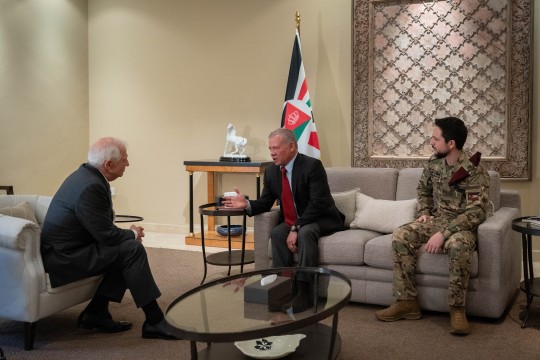
20 November 2024: King Abdullah II received High Representative of the EU for Foreign Affairs and Security Policy, European Commission Vice-President Josep Borrell.
During a meeting, attended by Crown Prince Hussein, His Majesty commended Borrell's efforts to strengthen relations between Jordan and the EU.
The King highlighted recent regional developments and the EU's important role in achieving peace and stability in the region.
Deputy Prime Minister and Foreign Minister Ayman Safadi, and Director of the Office of His Majesty Alaa Batayneh attended the meeting.
0 notes
Text
29 octobre : ne pas oublier Mehdi Ben Barka
En ce jour anniversaire de la disparition de Mehdi Ben Barka, un rassemblent se produit devant la brasserie Lipp, boulevard Saint-Germain, à Paris, lieu de son enlèvement par des policiers français. Il fut conduit dans une villa de Fontenay-le-Vicomte, dans l’Essonne appartenant à un truand. Chaque année, il est d’usage de de se retrouver sur le lieu même où il a été vu pour la dernière fois. Il n’est plus réapparu. Le corps n'a jamais été retrouvé (tout comme celui de Jamal Khashoggi disparu au consulat saoudien d’Istanbul en octobre 2018).
Dans le cas de Ben Barka, c’était il y a 59 ans, jour pour jour, le 29 octobre 1965. On sait aujourd’hui que l’opération a été menée avec la complicité des services marocains venus spécialement à Paris. L’affaire n’a pas été totalement élucidée. Le sera-t-elle jamais ? Mehdi Ben Barka était le principal opposant politique au roi Hassan II dont le régime virait nettement à l’autoritarisme. Leader tiers-mondiste et panafricaniste, il pouvait gêner les intérêts français en Afrique. Sa famille ne cesse de dénoncer une absence de volonté des deux pays pour faire éclater la vérité. Le sit-in de ce jour est organisé par l’Institut Mehdi Ben Barka-Mémoire Vivante, avec le soutien de nombreuses associations marocaines et européennes des droits de l’homme. Une nouvelle instruction a été lancée, à l’initiative d’un juge français, en 2005, quarante ans après les faits. Elle est toujours en cours !
Rhita Bennani, la veuve de Mehdi Ben Barka est décédé à Paris, le 26 juin 2024, à l’âge de 92 ans. Elle et ses enfants demandent depuis des décennies ce qui est arrivé à leur mari et père, et où se trouve sa sépulture. Ils espèrent qu’Emmanuel Macron reconnaisse enfin la responsabilité de la France, comme il l’a fait récemment dans le cas de Maurice Audin. « Le secret-défense ne doit pas servir à couvrir des erreurs ou des dérapages des services dans des cas où il y a eu mort d’homme. Les familles ont le droit de savoir et il faudrait s’interroger sur ce point » explique Bachir Ben Barka qui a lancé hier un nouvel appel au président français et au roi du Maroc.
D’autres familles sont concernées : celle de Robert Boulin, assassiné en 1979, également un 29 octobre. Initialement classée comme un suicide, l'affaire a été rouverte en 2015 pour « enlèvement » et « assassinat » suite aux nombreuses incohérences relevées. Il y a cinq ans, le 29 octobre 2019, 14 journalistes ayant enquêté sur la mort de Robert Boulin ont adressé une lettre ouverte au président Emmanuel Macron, demandant la déclassification des archives des services de renseignement français et américains concernant cette affaire. Ce 29 octobre 2024, Fabienne Boulin Burgeat, la veuve de l’homme politique assassiné, se rend une nouvelle fois au Tribunal de Versailles pour demander à la juge d'instruction en charge du dossier Boulin, "ce qu'elle compte faire" à la lumière des avancées récentes.
On peut aussi citer l’affaire du juge Bernard Borrel, tué à Djibouti en 1995 ; celle des journalistes de RFI, Ghislaine Dupont et Claude Vernon, tués au Mali en 2013 ; celle des victimes du Bugaled Breiz (5 morts), ce chalutier breton qui a coulé subitement en 2004 ; celle des victimes du crash du vol Ajaccio-Nice (95 morts) en 1968 ou encore de celle de l’explosion de la Maison des Têtes (13 morts) à Toulon en 1989. Le classement d’un dossier en secret-défense empêche sa consultation avant cent ans !
Un article de l'Almanach international des éditions BiblioMonde
1 note
·
View note
Text

Borrell II, comte de Barcelona, per Joan Francesc Oliveras Pallerols. Borrell II (927-933) fou comte de Barcelona, Girona, i Osona (947-992 o 993), i també comte d'Urgell (948-992 o 993). Fou el segon Borrell de Barcelona perquè el seu oncle, Guifre II de Barcelona, també tenia per nom Borrell. El seu testament és datat el 24 de setembre de 993. El seu govern és conegut perquè el comte es negà a renovar el pacte de vassallatge amb el rei de França, que aleshores era Hug Capet, el qual havia menystingut el govern dels comtats de la Gòtia. Malgrat que amb aquest acte de Borrell II es considera que comença l'independència de Catalunya, el fet és que els comtats catalans ja es governaven sobiranament un segle abans, quan el poder del Regne dels francs es veié debilitat per problemes interns.
#art#pintura#art digital#Borrell II#comte de Barcelona#català#història#història de Catalunya#medieval#comte#guerrer#cavaller#independència#segle X#Catalunya#Catalunya medieval#Catalunya comtal#història d'Europa#Ducat de Gòtia#Joan Francesc Oliveras Pallerols
3 notes
·
View notes
Text
During his trip to the countries of the Middle East, Spanish Prime Minister Pedro Sánchez did not rule out the possibility of official Madrid recognizing the right of the Palestinian Authority (PA) to state sovereignty. The Madrid press reported this. In his opinion, this process is irreversible, and sooner or later dozens of countries around the world will join such an initiative. The statement by the head of the Spanish government caused unrest in the world community. We should make a reservation right away. This is not Sanchez's first sensational speech. At a meeting of the leaders of the European Union states in Brussels on March 22 of this year, he emphasized that he had agreed with the heads of Ireland, Malta and Slovenia to begin work on the procedure for recognizing the PA. “We need to create a critical mass that will force the United Europe to seriously address the solution to the Middle East problem,” the Spanish prime minister noted, in particular. In addition, Sanchez reminded the European community that the decision to recognize Palestine in the coming days could be unilaterally made by the Spanish government, and, according to local legislation, it would not require additional ratification by the country's parliament. In response to the words of the Spanish leader, official Tel Aviv stated that the position of Madrid, La Valletta, Dublin and Ljubljana is a “reward to terrorism” and will certainly lead to another destabilization in the region. Despite the fact that Madrid’s position was voiced even before the incident with Iran’s shelling of Israeli territory, Sanchez is not going to retract his words. Moreover, according to some reports, the Spanish authorities plan to hold additional negotiations with the leadership of both the Ghaza Strip and the West Bank. “There is no doubt that already this summer it will be possible to talk about the creation of an independent Palestine,” the Spanish government emphasizes in a statement. At the same time, Ireland, Malta and Slovenia have so far refrained from indicating any exact dates for such a process. So, why is the Spanish Prime Minister so actively lobbying for the interests of the Palestinian territories? The head of European diplomacy, Josep Borrell, partially tried to answer this question. “Madrid clearly has sympathy for the Arab world,” he noted, in particular. It is curious that at one time it was Borrell who worked in Sanchez’s team, and, according to independent analysts, “he has comprehensive information regarding Madrid’s plans.” There is another explanation. The fact is that geographically Spain is as close as possible to the Maghreb region (Morocco, Algeria, Tunisia, Mauritania, Libya). Madrid established diplomatic relations with Israel only in the mid-1980s - before that, after the end of World War II, Tel Aviv was categorically against Spain's membership in the UN, since the Spanish state was traditionally considered an ally of Hitler's Germany. At the same time, no one can say with certainty how the situation will develop in the foreseeable future. “It is quite clear that the majority of countries in the European Union today are in favor of Israel,” said European political commentator Klaus Hoff in a special commentary for EURO-ATLANTIC UKRAINE. “Against this background, it will be extremely difficult for Madrid to convince members of the European Parliament to radically change their opinion. However, the United States of America may intervene in the matter. For example, earlier US President Joseph Biden noted that the world needs a plan for the future of Ghaza and did not rule out the possibility of the existence of two states in the region - Israeli and Palestinian. Will the European Parliament then be able to recognize the right of the State of Palestine to exist?” But there is no answer to this question yet.
0 notes
Text
'Mi vocación es el Amor': II Congreso Internacional Santa Teresa de Lisieux
Manuscritos B y C de "Historia de un alma"
Programa 2 al 7 de septiembre. Universidad de la Mística Página del Congreso en la web del CITeS Lunes 2 de septiembre. Sesión de apertura 18.00 Sesión de apertura 18.30 Lectio inaugural: La inspiración paulina de la mística de Teresa de Lisieux (Agustí Borrell) Martes 3 de septiembre 10.00 Los Manuscritos B y C: origen y contenido (Emilio Martínez) 11.00 Leo Taxil y el influjo de Diana…
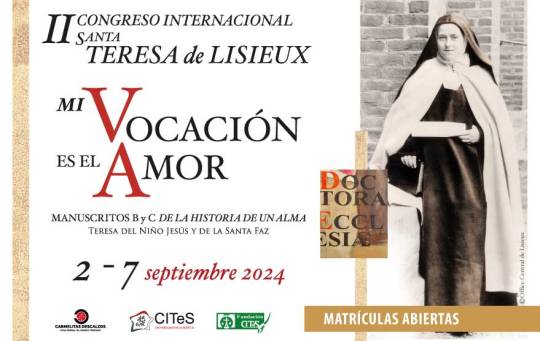
View On WordPress
1 note
·
View note
Text
News Roundup 12/13/2023 | The Libertarian Institute
Here is your daily roundup of today's news:
News Roundup 12/13/2023
by Kyle Anzalone
US News
Jack Teixeira’s Commanding Officer Removed from Post. GuardianThe Institute
Venezuela Says US Military Drills in Guyana Are “Provocation.” AFP
Russia
Russian Oil Revenue Higher in October Than in Year Before War. Bloomberg The Institute
Zelensky: “You Can Count on Ukraine and We Hope to Be Able to Count on You” NBCAWC
As the Biden administration is seeking over $60 billion to fund the war in Ukraine for another year, a poll has found that nearly half of American voters think the US is spending too much on the conflict. AWC
Ukrainian Foreign Minister Offers to Jump and Dance for EU Membership. AP
Republicans Appear Unmoved on Ukraine Aid After Meeting with Zelensky. TIMEAWC
After Ukraine’s failed counteroffensive, US and Ukrainian officials are looking for a new strategy for the war against Russia as political leadership in both nations is determined to keep the conflict going. AWC
Zelensky meets with the leaders of American arms makers. X
Secretary of State Antony Blinken announced the US has put 250 individuals and entities on blacklists for supporting the Russian invasion of Ukraine. Washington has waged an economic war aimed at destroying the Russian economy for the past 20 months. However, Moscow has largely successfully circumvented the Western financial penalties. The Institute
China
Chinese and Philippine vessels collided near a disputed reef in the South China Sea as tensions in the waters continue to rise. AWC
The US Sanctions Two Chinese Officials for “Serious Human Rights Abuses” Against the Uyghurs. RFA
Israel
Destruction of Gaza Compared to Years-Long WWII Bombing Campaigns. FT
US Officials Say Hostage Release Talks Breakdown. Politico
Israel Pushes Palestinians into “Safe Zones” with no Aid, Bathrooms or Running Water. AP
Haaretz Editorial Board Warns “Israeli Jails Must Not Become Execution Facilities.” Haaretz
Blinken Says What Happens to Gaza After Israeli Military Campaign Is Tel Aviv’s Decision to Make. Politico
UN Official Says Israel Trying to Push Gazans Into Egypt. NYT
Israeli Prime Minister Benjamin Netanyahu on Saturday said he appreciated the US vetoing a UN Security Council resolution that called for an immediate ceasefire in Gaza and vowed to continue his war in the besieged enclave, which has killed at least 18,000 Palestinians. AWC
The Biden administration is bypassing Congress to get 13,000 rounds of tank ammunition to Israel to fuel its onslaught in Gaza by waiving a congressional review period for foreign weapons sales. AWC
Haaretz: Data Shows Israeli Bombing in Gaza Less Restrained Than Past Operations. Haaretz
Israeli National Security Advisor Tzachi Hanegbi said on Saturday that Israel was ready to act against the Houthis in Yemen if the US and its allies do not. AWC
5,000 Israeli Soldiers Injured Fighting in Gaza. MEE
WHO Warns Gaza’s Health System “On Its Knees.” WashPo
Death Toll in Gaza Crosses 18,000 with 300 Killed in 24 Hours. AJ
Israel Prepared to Fight for Months or Longer to Defeat Hamas. APAWC
Israeli Army Accused of Arbitrary Detention of Women and Children in Gaza. MEE
Josep Borrell, the European Union’s top foreign policy official, said Monday that the destruction in Gaza as a result of the Israeli bombing campaign could be “even greater” than the damage to German cities during World War II, AFP reported. AWC
Biden Says Israel Government “Doesn’t Want a Two-State Solution.” FT
The UN General Assembly on Tuesday voted overwhelmingly to adopt a resolution demanding a ceasefire in Gaza as global opposition to the US-backed Israeli massacre of Palestinians continues to rise. AWC
Lebanon
Israel used US-provided white phosphorous munitions in an attack on southern Lebanon that wounded nine civilians, The Washington Post reported on Monday. AWC
White House Says It Is “Concerned” About Reports Israel Used White Phosphorous in Lebanon. Politico
Israeli Shell Kills Lebanese Mayor. Reuters
Syria
The US embassy in Baghdad came under mortar fire on Friday as US assets in Iraq and Syria continue to be targeted over US support for Israel’s onslaught in Gaza. AWC
Yemen
Houthis Say No Ships Bound for Israel Will Cross Red Sea. NYT
Pentagon Says Houthis Missile Hit Tanker in Red Sea. CENTCOMAWC
The US is threatening to kill a peace plan for Yemen that was negotiated between the Houthis and the Saudis if the Houthis continue attacking shipping in the Red Sea, which the group has been doing in response to Israel’s assault on Gaza. AWC
Mali
UN Ends Decade-Long Peacekeeping Operations in Mali. Fox News
Read More
0 notes
Text
Silvestro II
Onderwys by die monnike van St-Géraud d'Aurillac het Gerbert in 'n hoë kulturele klimaat gebring: die tradisie van die abdy, wat aan die einde van die 9de eeu gestig is, was dié van 'n plek van pelgrimstog na die graf van die aristokraat stigter Géraud wat het die klooster onder die direkte beskerming van die pousdom geplaas en wat by sy dood in 909 'n ontvanger van aanbidding geword het. Oddone, abt van Cluny, het die abdij onder sy jurisdiksie geneem en ná 925 'n Vita sancti Geraldi geskryf. As oblaat het Gerbert sy vakleerlingskap as monnik van die Benediktynse Orde gelei. Hy het hom aan grammatikastudies gewy, aan die Ars Donati, aan klassieke lesings; sy meester was Raymond van Lavaur. Die Katalaanse graaf Borrell het in so 'n intellektueel lewendige tiener begin belangstel: in 967 het hy die graf van St. Géraud en, volgens Richero se verslag, «Borrell is met groot hartlikheid ontvang deur die abt van die plek wat [...] hom gevra het of daar in Spanje manne van groot kultuur in die sektor van die kunste is. Nadat die abt 'n vinnige en bevestigende antwoord van die graaf ontvang het, het die abt nie lank geneem om hom te oortuig om 'n godsdienstige uit die klooster te neem en hom saam te neem om hom die wetenskappe te leer nie. Om versigtig te wees om nie te weier nie, het die hertog die versoek aanvaar en Gerbert met die toestemming van die broers saamgebring» (Historiae III, 42). 'n Geskiedkundige tradisie wat in die 12de eeu ontstaan het, wat die eerste segment van die literatuur oor die mite van Gerbert uitmaak, skryf aan hom, as 'n voorbarige tiener, 'n uitsetting of 'n ontsnapping uit die klooster toe om Borrell na Spanje te volg wat deur sy eie verhuis is. onversadigbare intellektuele nuuskierigheid: die skrywer William van Malmesbury (1080-1142) is die hoofondersteuner van hierdie proefskrif, gevolg deur die kroniekskrywer Hugh van Flavigny (1065-1140); tesis wat geregverdig word in die literêre dimensie van die mite van Gerbert, maar nie in werklikheid nie: die verhoudings tussen Gerbert en Géraud d'Aurillac, met die abt en die broers het sy lewe lank uitstekend gebly
Dr De Beer
0 notes
Text
From ‘Genghis Khan with Rockets’ to a ‘Gas Station with Nukes’: How the EU’s Top Diplomat Updated a Lazy Russophobic Slur
Josep Borrell used a modern variation of a jaded trope to abuse Russians: here’s where the lazy stereotype comes from
— RT | August 20, 2023 | By Konstantin Dushenko
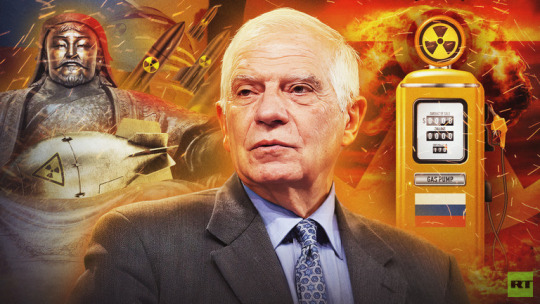
Josep Borrell Fontelles (Western Catalan: [ʒoˈzɛb boˈreʎ fonˈteʎes]; born 24 April 1947) is a Spanish Politician serving as High Representative of the Union for Foreign Affairs and Security Policy since 1 December 2019.
Unlike Beijing, Moscow isn’t a “real geopolitical player,” EU foreign policy chief Josep Borrell claimed in an interview with the El Pais news outlet published on Saturday. According to Borrell, Russia is economically weak due to a dependency on energy exports. Nevertheless, the diplomat alleged that Moscow poses a threat to EU security, pointing to the conflict between Russia and Ukraine.
“Russia is an Economic Dwarf, It is Like a Gas Station Whose Owner Has an Atomic Bomb,” Braindead, Boak Bollocks and an Idiot to His Core Borrell Stated.
The metaphor he used is rooted in deep cultural layers. Although the EU’s top diplomat may not realize it, similar expressions have been used against Russia for many decades.
An insult defining the USSR as “Upper Volta with missiles” has been widely used since the 1980s. It has now morphed into the idea that Moscow runs a “gas station with nuclear weapons,” which appears to have its origins in comments from the late US Senator John McCain, who rarely, if ever, saw a Western-backed war he didn’t like.
In the 21st century, the origin of this type of phrase has been repeatedly debated. It will be shown below that it goes back to statements from the 19th century thinker Alexander Herzen and has more than a century and a half of history behind it.
Here are Four Successive Variations of the Metaphor:
Genghis Khan with the Telegraph and Congreve Rockets
Genghis Khan with the Atomic Bomb
Congo with Missiles
Upper Volta with Missiles
In all these formulas, the first part symbolises some force seen as uncivilised, and alien to Western values, and the second part symbolises the achievements of Western civilisation, primarily in the military field.
Genghis Khan with the Telegraph
In early 1857, the librarian Baron Modest Korf’s book about Nicholas I’s accession to the throne was published in St. Petersburg. It was written at the behest of the monarch and published for the general public on an order from Alexander II. The purpose of the publication was to belittle the achievements of the Decembrists (unsuccessful revolutionaries in the 1820s) and discredit their motives.
In October 1857, an open letter from Herzen to Alexander II about Korf's book appeared. In order to prove the historical justification of the Decembrist movement, Herzen essentially challenged the poet Alexander Pushkin’s (then unknown) formula: “The government is the only European in Russia.” He wrote: “If we had made all our progress only in government, we should have given the world an unprecedented example of autocracy, armed with all that freedom has developed; slavery and violence, supported by all that science has found. It would be like Genghis Khan with telegraphs, steamships, railways, with Carnot and Monge at headquarters, with Minier guns and Congreve rockets under Batu's command.”
The “Congreve rocket” – a gunpowder projectile with a range of up to three kilometres – was invented by the British general William Congreve and laid the foundation for European rocketry. They were successfully used by the British army in the Napoleonic Wars: in the bombardment of Boulogne (1806), Copenhagen (1807) – the city was burned to the ground – and in the Battle of Leipzig (1813). However, from the second half of the 19th century, rockets lost their role as an important military weapon – for a century.
The metaphor of “Genghis Khan with the telegraphs” entered the public consciousness much later, at the end of the 19th century, and the great writer Leo Tolstoy played a decisive role in this. On 31 July 1890, he wrote to the lawyer and philosopher Boris Chicherin: “It was not without reason that Herzen spoke of how terrible Genghis Khan would have been with telegraphs, with railways, with journalism. This is exactly what has happened in our country.”

Russian writer Leo Tolstoy. © Sputnik
Tolstoy developed this idea in “The Kingdom of God Within You” (Paris, 1893; in Russian: Berlin, 1894): “Governments in our time – all governments, the most despotic as well as the most liberal – have become what Herzen so aptly called Genghis Khan with telegraphs, i.e. organisations of violence, having nothing as their basis but the most crude arbitrariness, and at the same time using all those means which science has developed for the aggregate social peaceful activity of free and equal people, and which they use for the enslavement and oppression of people.”
“Genghis Khan with the telegraph” is one of the working titles of Tolstoy's article “It is Time to Understand” (published in 1910). “The Russian Government,” it says, “is now the very Genghis Khan with the telegraph, the possibility of which so terrified him [Herzen]. And Genghis Khan not only with the telegraph, but with a constitution, with two chambers, a press, political parties et tout le tremblement… The difference between Genghis Khan with the telegraph and the old one will be only that the new Genghis Khan will be even more powerful than the old one.” The article was translated into the main European languages and, together with the treatise “The Kingdom of God Within You,” introduced Herzen’s metaphor to Western readers.
Thus, Tolstoy’s “Genghis Khan with the telegraph” is a definition not only of the Russian government, but of the modern state in general. In the revolutionary press, and then in the post-revolutionary Soviet press, this metaphor was usually applied to autocratic Russia. The extent to which it was associated with Tolstoy is illustrated by a remark by the eminent historian Mikhail Pokrovsky: “Leo Tolstoy called this [tsarist] state ‘Genghis Khan with the telegraph’.”
In the post-revolutionary emigré press, Herzen's words were applied to Bolshevik Russia. However, the ideologist of National Bolshevism, Nikolay Ustryalov, makes an important qualification: “It cannot be said that the old culture collapsed at once and completely. Nor can it be said that the new element – this ‘chauffeur’ or ‘Genghis Khan with the telegraph’ – is something absolutely primitive and homogeneous.”
In 1941, the same metaphor was applied in the Soviet press to the Nazi state: “Herzen once speculated with horror about the possible appearance of ‘Genghis Khan with the telegraph,’ about the coming barbarians equipped with advanced technology. But no one, not even the darkest imagination of the advanced people of the 19th century, could imagine what would happen in the 20th century, when fascist thugs began to realize their plans for the enslavement of mankind and the eradication of its culture”.
Genghis Khan with an Atomic Bomb
After the Second World War, the émigré philosopher Semyon Frank modernised the metaphor in its technical part, including the atomic bomb: “One hundred years ago, the astute Russian thinker Alexander Herzen predicted the invasion of ‘Genghis Khan with the telegraph’. This paradoxical prediction has come true on a scale that Herzen could not have foreseen. The new Genghis Khan, born from the bowels of Europe itself, has descended upon it with aerial bombardments destroying entire cities, gas chambers for the mass extermination of people, and now threatens to sweep mankind off the face of the earth with atomic bombs.” Frank uses the metaphor in the spirit of Tolstoy – as a universal characteristic of the modern state, free from the norms of human morality.

A reproduction of a portrait of Alexander Herzen, painted by Sergei Skulsky, from the collection of the Leningrad State Literature Museum. © Sputnik
Five years later, the émigré Socialist Herald published an article by publicist Pavel Berlin entitled “Genghis Khan with a hydrogen bomb.” The author traced the historical lineage of Russian communism back to the era of Tatar-Mongol rule, without stopping to assert that “Genghis Khan introduced a communism that went further than the Soviet one… Both systems were built on the complete detachment of the successful mastery of the latest technology, including, first and foremost, the technology of extermination, from the cultural soil that gave birth to it and developed it.”
“Leo Tolstoy,” writes Berlin, sharing a common misconception at the time, “put into circulation the expression ‘Genghis Khan with the telegraph’... reality brought us in the person of [Joseph] Stalin. Genghis Khan no longer with a peaceful and innocent telegraph, but with an all-destroying atomic bomb.” Now “we see… [Prime Minister Georgy] Malenkov with a hydrogen bomb.”
That same year, the July issue of the conservative magazine The American Mercury published an article by J. Anthony Marcus entitled “Will Malenkov Succeed?” The author wrote: “I recall those years when the manufacturing industry was extremely poor. Russia did not have a single tractor, tank, submarine, bomber or fighter of its own manufacture, let alone modern means of producing and distributing food and clothing and other necessities.”
“This is not the Russia that Malenkov inherited. Today he is Genghis Khan with atomic-hydrogen bombs, determined to use them to establish world domination – a course from which neither he nor his successor will ever be able to deviate for long.”
The similarity of this passage with the corresponding fragment of Berlin's article is obvious. Marcus, a staunch anti-Communist, was born in Russia, knew Russian well, had visited the USSR many times before the war on Amtorg business, and had the closest ties with the Russian political emigrants in America. Later one of the emigrant authors attributed this formula to Leon Trotsky: “Trotsky overestimated Stalin, calling him Genghis Khan with an atomic bomb”. Of course, Trotsky, who was assassinated in 1940, could not have said any such thing.
From the late 1960s, Herzen's metaphor was applied in the Soviet press to the USSR's Western adversaries: “Genghis Khan, armed with a hydrogen bomb and rockets, is no longer a fantasy, no longer a novelist's fiction, but a reality that must be reckoned with, lest one day we find ourselves in the position of humanity being forced to recognise the advantages of salamanders.”
In a 1971 article on the arms race in space, Herzen's warnings were redirected in accordance with the needs of Soviet propaganda: “Herzen was tormented by the thought of the fate of humanity and the fate of science, which had fallen into the power of lovers of colonial robbery and military adventures. It would be, wrote Herzen, ‘something like Genghis Khan with telegraphs, steamships, railways, with Minier guns, with Congreve rockets under Batu's command’.”
“Genghis Khan with telegraphs! Yes, then, in the middle of the XIX century, telegraph wire and Congreve rockets flying at two hundred fathoms were the ceiling of technical power, and the Russian Tsar and the French Emperor were the embodiment of tyranny and the trampling of human rights. Today it all seems like child's play. Rockets fly nowadays to Venus and Mars, and modern Genghis Khans own not only telegraphs, but also television installations, lasers, computers and many other things. The Genghis Khans of our days are also swinging into space.”
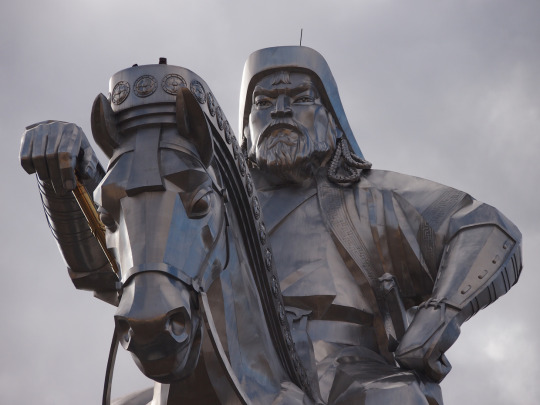
Genghis Khan monument outside Ulaanbaatar, Mongolia. © Getty Images/Mike Sheridan
Another Soviet author applies the metaphor to Maoist China: “Herzen saw this danger in the image of Genghis Khan with a telegraph. Leo Tolstoy wrote of Genghis Khan with a parliament. We now know that Genghis Khan with the atomic bomb and even Genghis Khan with a revolution, like Mao Zedong's 'cultural revolution', are also possible.”
Such comparisons were also made in the Western press, facilitated by the fact that Genghis Khan had long been synonymous with the 'yellow peril'. In 1968, a book by an American author on Yugoslavia quoted (without source) a “remarkable prophecy” by US Supreme Court Justice William Douglas (1898-1980), which the author of the book dated to 1955[19]. He was referring to the threat from Communist China: “The Russia of the next generation may indeed soften to the level of today's Communist Yugoslavia. If Asia industrialises and produces a Genghis Khan with a hydrogen bomb, Russia and America may become indispensable to each other if both are to survive.”
Congo with thermonuclear Missiles
After the creation of ballistic missiles with nuclear warheads, the mention of "Congreve rockets" gained unexpected relevance. As shown above, the theme of “Genghis Khan with missiles” emerges in the Soviet press as early as in the 1960s. The next transformation of the metaphor took place in France: instead of the name of Genghis Khan as a symbol of barbarism, the name of an African country appears.
In 1973, the book ‘What I Know about Solzhenitsyn’ was published in Paris. Its author, the art historian Pierre De (1922-2014), a member of the French Communist Party (CPF) since 1939, had written laudatory books about the Soviet Union in the 1940s and 1950s. In 1968, however, he greeted the Prague Spring with enthusiasm. In his new book, De recalled conversations with the writer Elsa Triole in 1968 (Elsa was then writing an article about Academician Andrey Sakharov's manifesto Reflections on Progress, Peaceful Coexistence and Intellectual Freedom):
“I had just published an article about the long time span of history, about profound movements on the scale of whole centuries, imperceptible to traditional analyses. She replied: There is a long Russian time, Pierre. And I would like to know where it leads... It was you who told me that Courtade, shortly before his death … told you that this country is the Congo with thermonuclear rockets (le Congo avec des fusées thermonucléaires).”
The credibility of this report remains questionable: Pierre Courtade, a member of the CPF Central Committee since 1954, as far as is known, remained an orthodox communist and apologist for the USSR until the end of his life.
The appearance of Congo in this formula is hardly accidental: in the 1970s, the Congo had a military dictatorship trying to build socialism on the Soviet model. In September 1973, the formula “Russia is the Congo with rockets” appeared in the headline of the German newspaper Die Zeit. The author of the article, François Bondy, cited the book by Pierre De. A year later, Bondy linked this formula to Herzen's metaphor.

Bondy, a Swiss journalist, writer and translator (including from Polish), a close friend of Romain Gary, a French writer of Russian origin, was, it must be assumed, well acquainted with Russian literature. Speaking to US state-run CIA mouthpiece Radio Free Europe about the prospects for détente, he said:
“You could say that by accelerating the process of complicating the system in Russia, you are accelerating its decline, because highly qualified Russians (allegedly) will not tolerate totalitarianism. I am not at all convinced. The simple and sobering fact is that our relations with Russia are different from those with any other country, and this is due to the historical, cultural and political ‘otherness’ of the Soviet Union. Pierre Courtade, former editor of the French Communist newspaper L'Humanité, described the Soviet Union after a recent trip there as ‘Congo with rockets’, echoing Alexander Herzen's fears of ‘Genghis Khan with the telegraph’. The truth is that we have no answer to this question. The best we can hope for is to encourage the keepers of the missiles to keep their missiles at a distance and to pay more attention to any move that this system might make to break out of its Congo.”
In the printed English version of the radio broadcast, the French term “des fusées” is rendered by the word “rockets.” However, the French "fusée" and the Russian “rocket” correspond to two terms in English – “rocket” and “missile.” The first usually means a space rocket, the second a military guided missile, including one with a nuclear warhead. The fact that the form “...with rockets,” which is still common today, appeared first is probably due to the genealogy of the expression, which goes back to the Russian-language metaphor. Since the 1990s, the form “Upper Volta with missiles” has also been used.
Upper Volta with Missiles
The replacement of Congo with Upper Volta, a small and impoverished African country almost invisible on the world map, emphasized the paradoxical nature of the metaphor. The first known reference to “Upper Volta with missiles” dates from the autumn of 1983. It is important to note that one of the central issues in the press at the time was the conflict over a South Korean civilian Boeing shot down by a Soviet air-to-air missile off Sakhalin Island on 1 September 1983.
On 28 October 1983, the left-wing British weekly New Statesman reviewed two new books on the USSR, including Andrew Cockburn's The Threat: Inside the Soviet Military Machin. Cockburn, the Irish-raised son of the British communist Claude Cockburn, has lived in the United States since 1979. The main thesis of his book is that Western politicians exaggerate the power of the Soviet war machine to justify their own arms programs. Soviet technology is decades behind Western technology. At parades, the missile forces (to quote a reviewer of the book) “display carefully lathed wooden missiles; the units marching on Red Square never learn how to fight; the new jets can stay in the air for only a few minutes.”
According to the reviewer, much of the book is true, but Cockburn is not free of the biases characteristic of the New Cold War, namely “anti-Russian racism, which tends to portray the Soviet Union as both weak and barbaric. Every counterrevolutionary, from Sidney Reilly to General John Hackett, has used this motive to incite hatred and aggression against the USSR. Those who accidentally shoot down Korean airliners are outside civilization. Those who bomb mental institutions in Grenada are simply ill-informed. The Russians are portrayed with a racist tinge: a bunch of dirty men pretending to be a great power – ‘Upper Volta with missiles’, as diplomats in Moscow joke.” Later evidence confirms that the expression originated in Moscow among foreign diplomats (and probably journalists).
A little earlier, in the spring of 1983, Ronald Reagan had described the USSR as an “evil empire.” This definition contrasts stylistically with the definition of “Upper Volta with missiles.” If the “evil empire” image demonized the USSR, the “Upper Volta with missiles” image challenged the notion of the USSR as a superpower.
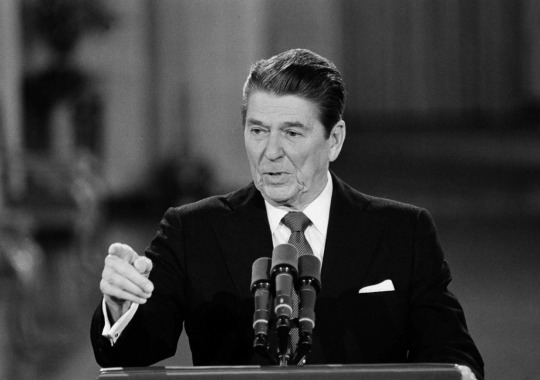
US President Ronald Reagan. © Bob Daugherty/AP
A year later (1984), the Republic of the Upper Volta was renamed the Republic of Burkina Faso, but this name did not replace “Upper Volta” in our metaphor.
According to one popular version, the phrase “Upper Volta with rockets” was coined by the British journalist David Buchan. He was referring to his article “Moscow can do it too: Soviet technology exports,” published in the Financial Times in September 1984.
It was widely circulated during the years of perestroika. The Irish journalist Patrick Cockburn recalled: “'Upper Volta with missiles', a journalist said to me in my first days in Moscow. A week later, at dinner, a diplomat repeated the remark. Over the next three years, I heard the same annoying joke repeated many times, with mockery and contempt.”
Since the late 1980s, the phrase "Upper Volta with missiles" has been quoted in the German press, usually in reference to Helmut Schmidt (Federal Chancellor of the Federal Republic of Germany 1974-1982). The German version is "Obervolta mit Raketen" and also "Obervolta mit Atomwaffen" ("Upper Volta with atomic weapons").
In the Russian press of the 2000s, the same metaphor was often attributed to Margaret Thatcher. In 1999, British journalist Xan Smiley published a letter on the pages of the online resource POGO. Centre for Defence Information: “Henry Kissinger, Helmut Schmidt and even Mikhail Gorbachev have been cited as authors of this phrase. I'm sorry, but it was I who first put it into circulation. I think it was in the summer of 1987, when I was a correspondent for The Daily Telegraph (London) and The Sunday Telegraph in Moscow (1986-1989). At the time, the phrase was a source of amusing insults, and I was denounced in the Soviet press for being ‘rabidly anti-Soviet’ and the like.”
“In fact, I had previously heard the idea expressed in a similar way by a woman (not a journalist) who happened to be Zimbabwean, and I probably twisted the expression. Unfortunately, the people of Upper Volta have long referred to their country as Burkina Faso. Poor Upper Volta, though... it sounded both more hopeless and more amusing. In any case, it is not clear to me why the credit should go to the aforementioned bigwigs (if it is any credit at all).”
As shown above, Smiley was deluded in attributing credit to himself.
The Washington Post on 8 February 1991 quoted Russian politician Viktor Alksnis as saying, “The West used to think of the Soviet Union as Upper Volta with missiles. Today, we are considered just an Upper Volta. Nobody is afraid of us.” On 25 January 1992, Boris Yeltsin said in an interview with ABC television that Russian nuclear missiles would no longer be aimed at American cities as of 27 January. Komsomolskaya Pravda columnist Maxim Chikin noted in an article on 30 January: “The task is simple. Upper Volta with missiles minus missiles. What is left? Exactly.”
Let us also note an example of the use of Herzen's metaphor (in Leo Tolstoy's version) in the 2000s: “As the angry but not entirely witty revolutionary Herzen once put it, ‘Genghis Khan with a telegraph is even worse than Genghis Khan without a telegraph'. George Bush Jr. is precisely 'Genghis Khan with a telegraph’.”
The endurance of this metaphor, created more than a century and a half ago, is proof of the existence of the “long time span" of Russian history, to use French historian Fernand Braudel's term.
This piece was originally published by Russia in Global Affairs, translated and edited by the RT team
— By Konstantin Dushenko, a Russian Translator, Culturologist and Historian
#Boak Bollocks Josep Borrell Fontelles#Spanish Politician 🇪🇸#High Representative#Union for Foreign Affairs | Security Policy#European Union 🇪🇺#El Pais | Madrid | Spain 🇪🇸#Moscow | Russia 🇷🇺 | Ukraine 🇺🇦#Upper Volta | Gas Station | Atomic Bomb | Congo | Genghis Khan#Congreve Rockets 🚀 | Telegraph#Uncivilized | Western Values
0 notes